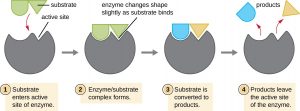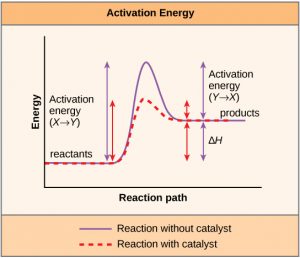September 22, 2020, by Chris Handley
Going Greener Digitally with Enzymes
Nature is the Best Chemist

The enzyme – grey – takes a substrate and binds to it, performing a reaction to produce the product/s
Nature is the best synthetic chemist, capable of manufacturing chemicals in an energy-efficient manner and with biodegradable by-products. Millions of years of evolution have explored and optimized reaction pathways, and we would be foolish not to exploit that chemistry.
Critical to this efficiency are enzymes – biological catalysts – that are not consumed by the reaction. Rather, enzymes speed up the rate of reactions by providing an alternative mechanism for the reaction to proceed by.
Enzymes are naturally occurring catalysts and thus environmentally friendly and biodegradable. Enzymes can be modified, either directly, or through the engineering of bacteria to produce new enzymes. The creation of novel enzymes is critical as we move to a greener and more sustainable chemical industry. Such enzymes are critical to future chemical, fuels, food and materials production.
Designing novel enzymes is not cheap, and there are many factors to be considered. Efforts are put into expanding the possible reactions that an enzyme allows us to perform, or the substrates that an enzyme can act upon. We also seek enzymes that work more readily under the conditions of industrial settings, rather than in the finely tuned biological conditions of a living organism.
 Computational Discovery
Computational Discovery
Screening the vast array of possible enzymes – and modifications – is not tractable, efficient, or environmentally friendly. This is compounded with the advent of COVID-19. There is a need to use computational tools to accelerate discovery.
Part of the challenge of designing new enzymes is not just understanding the structure and function of the enzyme, but how an enzyme interacts with a variety of co-factors, the solvent, and the substrates and products.
Subsequently, we want to be able to perform simulations of enzymes – and their mutations – in a manner that allows us to screen potential candidate enzymes rapidly, testing each in different conditions. Typically, most strategies for enzyme discovery have been specific to a particular case, and the methodology is not transferable to other enzymes.
Sustainable Software
The Digital Research Service (DRS) is engaged with research in this field, supporting Dr Christof Jaeger, Assistant Professor in the Faculty of Engineering and member of Sustainable Process Technologies Group, as well as the Green Chemicals Beacon of Excellence.
The DRS is providing specialist computational expertise in High-Performance Computing, scientific programming, combined with domain specialism in computational chemistry. We are exploring and designing methodologies and workflows that combine super-computing, machine learning, and data mining to accelerate novel enzyme discovery. Not only is the goal to develop a workflow to develop enzymes, but also to create a sustainable workflow that would allow end-users to reuse, modify and extend this for their own work.
If you are seeking to perform computational chemistry, biochemistry, or materials science, and need advice and support, please get in touch with the DRS.
Sorry, comments are closed!
